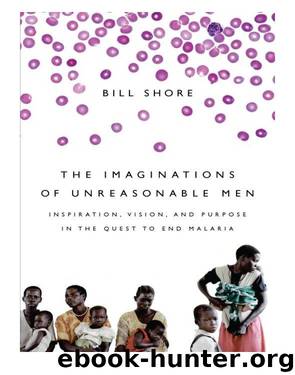The Imaginations of Unreasonable Men by Bill Shore

Author:Bill Shore
Language: eng
Format: epub
Publisher: PublicAffairs
Published: 2010-10-20T04:00:00+00:00
In October 2008 I flew to Seattle to check in with the global health experts at the Gates Foundation on the progress of their malaria vaccine initiative. Joe Cerrell, director of global health and advocacy for the foundation, echoed his boss in explaining that, first, markets don’t work for 2 billion of the world’s poorest, and, second, “sheer visibility” is a challenge, in that “the problems are 7,000 miles away and don’t factor in to the psyches of those who could make a difference.” Perhaps most important, the Gates staff had come to learn, as Steve Hoffman and Peter Hotez had, that “the best science is not always the best solution,” in the words of Tom Brewer, senior program officer for infectious disease at the foundation. Sometimes the best science is the science one can afford to scale.
With the stakes so high, one might expect more effective leadership and coordination among the various malaria experts and activists. But for decades there was very little leadership, because there were few resources and little to lead. Malaria’s victims were too voiceless and invisible to attract funds, talent, or champions to their cause. The fight against malaria was more like a game of whack-a-mole. Each time the parasite was attacked from one direction it popped up in another. There was no one calling the shots.
By any measure, the battle was too underfunded to be considered a fair fight. A study by the Malaria R&D Alliance, an international coalition of malaria research groups, found that spending on malaria research and development in 2004 amounted to just $323 million, less than 0.3 percent of total health spending worldwide, even though malaria accounted for 3 percent of the global disease burden. 23
Of that $323 million, $129 million came from the U.S. government. European governments contributed $31 million, and the private sector, $39 million. The nonprofit sector provided 32 percent of the funding, with an investment of $103 million.24
But even a few hundred million dollars gets spread too thin when it has to stretch across a planet with such large swaths of territory hospitable to mosquitoes and malaria. A 2008 report by the Kenya Medical Research Institute showed that only twenty-four countries received more than $1 per person for each person at risk, and only seven countries received more than $4 per person. The Democratic Republic of the Congo, Côte d’Ivoire, and Pakistan received only 11 cents annually per person at risk. Sixteen countries, including seven of the poorest in Africa and two of the most densely populated at-risk nations (India and Indonesia), received less than 50 cents for each person at risk.25
It was hardly a scenario for attracting the best and the brightest to the field, stimulating innovation or entrepreneurship, or seeding a new generation of doctors willing to commit to helping the most voiceless and vulnerable people in the world. Tropical medicine had become like a historic landmark in a once trendy neighborhood that time had passed by and that had long since fallen out of fashion.
Download
This site does not store any files on its server. We only index and link to content provided by other sites. Please contact the content providers to delete copyright contents if any and email us, we'll remove relevant links or contents immediately.
| Administration & Medicine Economics | Allied Health Professions |
| Basic Sciences | Dentistry |
| History | Medical Informatics |
| Medicine | Nursing |
| Pharmacology | Psychology |
| Research | Veterinary Medicine |
Periodization Training for Sports by Tudor Bompa(8170)
Why We Sleep: Unlocking the Power of Sleep and Dreams by Matthew Walker(6618)
Paper Towns by Green John(5087)
The Immortal Life of Henrietta Lacks by Rebecca Skloot(4525)
The Sports Rules Book by Human Kinetics(4290)
Dynamic Alignment Through Imagery by Eric Franklin(4116)
ACSM's Complete Guide to Fitness & Health by ACSM(3989)
Kaplan MCAT Organic Chemistry Review: Created for MCAT 2015 (Kaplan Test Prep) by Kaplan(3939)
Introduction to Kinesiology by Shirl J. Hoffman(3721)
Livewired by David Eagleman(3682)
The Death of the Heart by Elizabeth Bowen(3551)
The River of Consciousness by Oliver Sacks(3536)
Alchemy and Alchemists by C. J. S. Thompson(3448)
Bad Pharma by Ben Goldacre(3354)
Descartes' Error by Antonio Damasio(3229)
The Emperor of All Maladies: A Biography of Cancer by Siddhartha Mukherjee(3063)
The Gene: An Intimate History by Siddhartha Mukherjee(3047)
The Fate of Rome: Climate, Disease, and the End of an Empire (The Princeton History of the Ancient World) by Kyle Harper(3003)
Kaplan MCAT Behavioral Sciences Review: Created for MCAT 2015 (Kaplan Test Prep) by Kaplan(2936)
